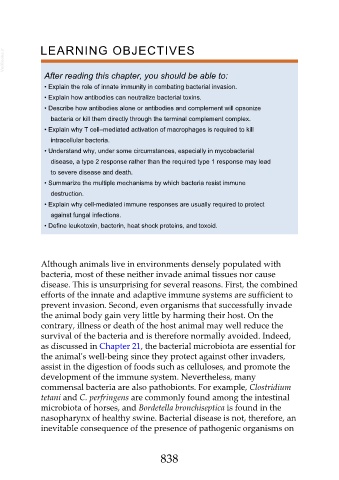Page 838 - Veterinary Immunology, 10th Edition
P. 838
VetBooks.ir LEARNING OBJECTIVES
After reading this chapter, you should be able to:
• Explain the role of innate immunity in combating bacterial invasion.
• Explain how antibodies can neutralize bacterial toxins.
• Describe how antibodies alone or antibodies and complement will opsonize
bacteria or kill them directly through the terminal complement complex.
• Explain why T cell–mediated activation of macrophages is required to kill
intracellular bacteria.
• Understand why, under some circumstances, especially in mycobacterial
disease, a type 2 response rather than the required type 1 response may lead
to severe disease and death.
• Summarize the multiple mechanisms by which bacteria resist immune
destruction.
• Explain why cell-mediated immune responses are usually required to protect
against fungal infections.
• Define leukotoxin, bacterin, heat shock proteins, and toxoid.
Although animals live in environments densely populated with
bacteria, most of these neither invade animal tissues nor cause
disease. This is unsurprising for several reasons. First, the combined
efforts of the innate and adaptive immune systems are sufficient to
prevent invasion. Second, even organisms that successfully invade
the animal body gain very little by harming their host. On the
contrary, illness or death of the host animal may well reduce the
survival of the bacteria and is therefore normally avoided. Indeed,
as discussed in Chapter 21, the bacterial microbiota are essential for
the animal's well-being since they protect against other invaders,
assist in the digestion of foods such as celluloses, and promote the
development of the immune system. Nevertheless, many
commensal bacteria are also pathobionts. For example, Clostridium
tetani and C. perfringens are commonly found among the intestinal
microbiota of horses, and Bordetella bronchiseptica is found in the
nasopharynx of healthy swine. Bacterial disease is not, therefore, an
inevitable consequence of the presence of pathogenic organisms on
838

